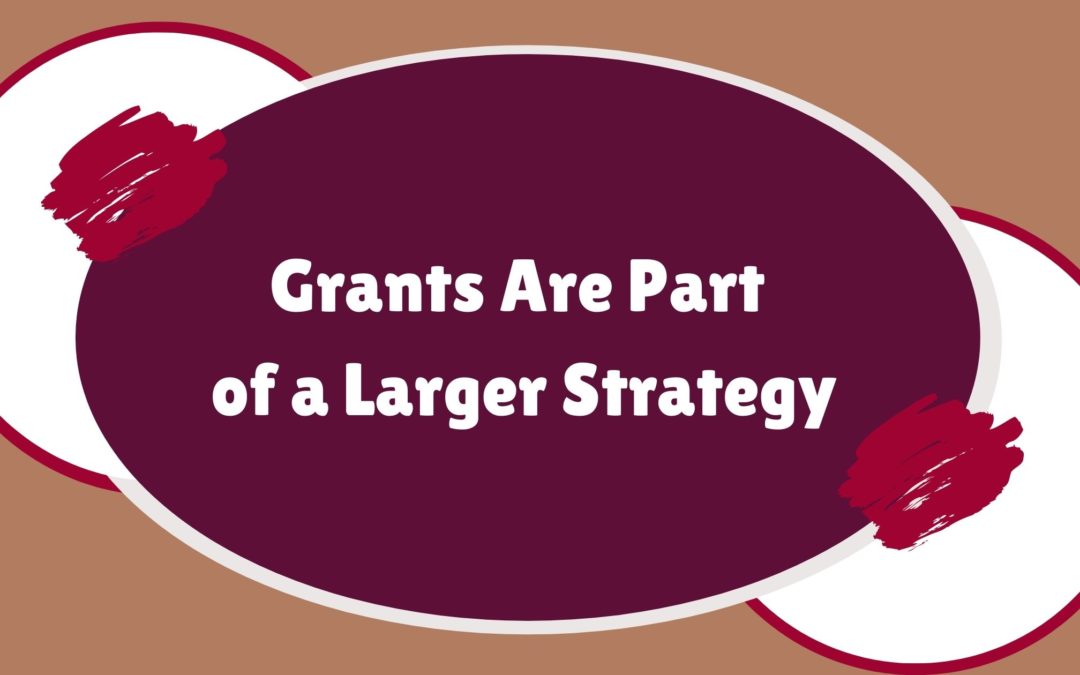I was in a few nonprofit founder groups recently where the question was, “I just got my tax exempt status! Where do I find the grants?” Or someone told them they would qualify for grants and so they have tunnel vision and will listen to no other solution to their funding woes. I shake my head and keep scrolling because I can’t help. At this stage, having the single strategy of getting grants is a bad strategy and it will not keep you going long-term even if you do get a grant in the first few years.
Grants Are Part of the Fundraising Strategy Hierarchy
The Fundraising Strategy Hierarchy is a framework helps you visualize the levels of fundraising. Fundraising builds on itself and mastery at each level provides skills and resources for the next level. Each level and step builds on the step and level before it and requires more resources, skills, and infrastructure to successfully fundraise. Grants fit in to the Fundraising Strategy Hierarchy at Step 3 above Individual Donors (Step 1) and Companies, Churches, and Dominations (Step 2).
Grants are in Step 3 because they require more resources, skill, and infrastructure than the 2 steps before it. The grant levels need connections which are often found in donors and Board members. Grants also require the nonprofit to show community support. Having a donor base and measuring by number of donors and donation total is a good way to show this community support. They also need dedicated resources like someone to write and keep up with expenses and outcomes in order to report back to the funder. For example, in level 3 of Grants, a Federal grant will take approximately 50 hours to complete. Grants will also need special training and writing skills. Infrastructure will need at minimum: grant management software, grant calendar, a program with measurable outcomes from at least three years, operational budget, tax filings for three years
Grants Should be Part of Your Larger Strategy
Using grants as your only strategy is a recipe for unsustainable funding. Grants aren’t fast money. They take 3-6 months to receive notice of award. You should have a mix of funding from short-term (1-3 months), Mid-term (3 months to a year), and long-term or multiple years.
Foundations don’t like to be your sole funder. Many times if you write a grant for the same project that you were awarded before, you will get declined unless the grant is for general operating funds. Foundations want nonprofits to be able to stand on their own and not get dependent on grant funds. They know that being dependent isn’t healthy for the nonprofit.
Funding priorities shift. COVID-19 is an example. When COVID-19 first started shutting down the world, Foundations began switching funding strategies to COVID-19- related projects including research. They responded to a rapidly changing environment.
Having multiple strategies helps you be more nimble as the economic environment changes. When one strategy isn’t working or is not getting the traction you need, then you can shift resources to strategies that are working. It’s exactly why some nonprofits had the best years ever during the Pandemic of 2020 and some were on the brink of closing. The successful organizations were able to shift resources from in-person events and grants to online events and individual donors.
A Fundraising Plan is Your Overall Fundraising Strategy. A Fundraising Plan is a document that defines your fundraising goals. These goals are supported by strategies and activities that will help you reach your goals. This plan uses a mix of strategies from the Fundraising Strategy Hierarchy’s steps and combines activities from each level to create a robust plan for funding.
Being Grant Ready at Your Stage is Your Best Strategy
You will dramatically increase the odds of getting the grant if you have all the things in place that demonstrate to a funder that you will be a good steward and can handle the grant funding they will provide. When your nonprofit is grant ready, you are saying to a Foundation that you are a good investment and have minimized their risk in investing in you. Using the Grant Readiness Plan and a Fundraising Plan will help you become a great investment and competitive for the grants they apply for.
Grants should not be your sole source of funding. It is unhealthy for your organization and sets you up for long-term failure. It keeps you from being able to do the things that don’t move your nonprofit forward. Look for resources that will help you get grant ready in the show notes and description.
